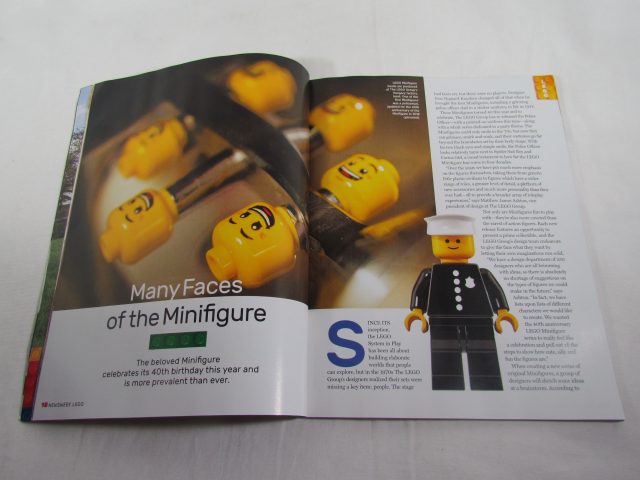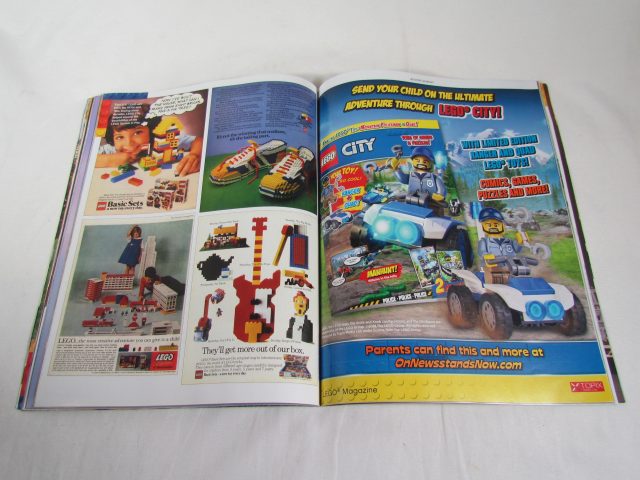When you play with LEGO, it’s a birthday party every day! Throughout 2018, the LEGO Group has been celebrating two very special birthdays in the form of the patented LEGO brick (60 years) and minifigure (40 years). To celebrate the occasion, LEGO has given us Wal-Mart exclusives, a special 60th anniversary set, and a series of collectible minifigures dressed for a party. Thanks to Newsweek, we now also have a special edition magazine that is entirely devoted to our favorite interlocking plastic building bricks. We finally got our hands on a copy and are eager to share our thoughts with you.

Having read this 100 page special issue cover-to-cover, I can confidently say the overall presentation was excellent. High quality glossy pages not only looked good, but felt nice to the touch. I also found plenty of eye candy inside, including a wide variety of page layouts and illustrations to help hold my interest.
Speaking of illustrations, Newsweek appears to have taken LEGO’s “only the best is good enough” approach. I found the images to be phenomenal and enjoyable to look at, whether it was snapshots from inside LEGO headquarters or of Barack Obama sitting next to one of Nathan Sawaya’s sculptures. As a history-buff, I was also pleased to see reproductions of vintage advertising and photographs, one of which I had never seen.
In addition to the magazine’s overall appearance, I felt another key strength was its diverse range of content. A total of fifteen topics were covered, including articles on the LEGO Ideas platform, LEGOLAND, minifigure history & design, a look inside the LEGO factory, and interviews with a LEGO artist and LEGO Architecture designer. Another bonus included historical timelines showcasing both the history of the LEGO Star Wars theme and of the company itself.
Even though the photography and diverse approach were great, I couldn’t help but feel like these two areas came at the expense of the written content. Fifteen articles provides a lot of material to cover, which has unfortunately contributed to a lack of depth in many of them. I was particularly disappointed in the “LEGOstalgia” article, which presented a look at four classic LEGO sets. Absent from the brief paragraph-long write-ups were meaningful notes on the historical context behind the sets’ design or significance.
There were also at least two historical inaccuracies that stood out. One page featured four magazine advertisements identified as examples from the UK in the 1960s and 1970s, but one of the ads shown was actually from the U.S. in the 1960s. In another instance, an article implied that the LEGO System lacked people prior to the birth of the minifigure, completely ignoring the older buildable figures that even predated the minifigs most primitive form. These figures were often advertised alongside models such as trains, which appeared much smaller in scale. In fact, this imbalance in scale was one of the contributing factors that led to the modern minifigure.
In light of these flaws, was I completely disappointed? Absolutely not! I enjoyed leafing through all the illustrations, many of which document LEGO in its present form. From an historical standpoint, this adds enough value for me to want to keep it. Conversely, when it comes to reading material on LEGO history itself there are arguably much better resources out there. The intended audience is clearly the general public, and I am sure they will enjoy it. When it comes to online retailers Media Lab Books and Amazon, the magazine is currently sold out. If you are interested in snagging a copy, you might try checking your local newsstand or scavenging for one on eBay.













Does the article mention Kiddicraft anywhere?
Hi David. The magazine does not reference Kiddicraft anywhere, nor does it offer an in-depth history of the company. They do, however, reference Kiddicraft via the history section of the LEGO website. https://www.lego.com/en-us/legohistory/automatic-binding-bricks
“The bricks that Ole Kirk Kristiansen brings home from the first demonstration in 1946 have been invented by a Briton, Hilary Fisher Page – but they have not been a success for his company, Kiddicraft. In the late 1950s the LEGO Group contacts Kiddicraft to ask whether they object to the LEGO brick. They don’t. On the contrary, they wish the LEGO company good luck with the bricks – with which Kiddicraft has not enjoyed much success. In 1981 the LEGO Group purchases the rights to Kiddicraft bricks from the descendants of Hilary Fisher Page.”
There’s no way that Disney *didn’t* mandate two Reys on the cover and not a single Luke Skywalker minifigure…
^ What’s your point?
There’s still Darth Vader, Yoda and Lando Calrissian from the Classic Trilogy, though… I don’t really find Luke Skywalker that interesting, either as a character or a minifigure…
What’s your point?
The cover is out of whack. With what, 29 different versions at last count? Luke Skywalker’s is a hugely important character for Lego Star Wars, but he’s nowhere to be found on the cover, while Disney’s replacement for him, Rey, appears twice (and is flanked by Finn and Disney!Lando).
@Jester: Ah, yes — Disney does seem more interested in promoting its own IP than the IP it inherited from Lucasfilm. (I was concerned you were making a very different point…)
Where can we buy this magazine? I cant find it anywhere to buy it and to be sent in Slovenia Europe. Or at least pdf version.
robert glazer@siol.net
Was very exited to see this issue back in stock at Media Lab Books just now, since I find that this issue already is pretty expensive on ebay.. But quite disappointing to see that in my case, it’s approx. $30 in postage for a $11 magazine even from “the source”, which makes for a VERY expensive magazine. At 100 pages, at that.
So it’s actually a few $ cheaper to just purchase it at ebay now.. :(